Key takeaways:
- Understanding key weather terms like humidity, barometric pressure, and dew point enhances the ability to interpret forecasts effectively.
- Analyzing weather data involves recognizing trends and verifying information from reliable local sources.
- Personalizing weather app settings and utilizing clear layouts improve the accessibility of important weather information.
- Recognizing weather patterns and using forecasts can significantly influence planning and decision-making for outdoor activities.
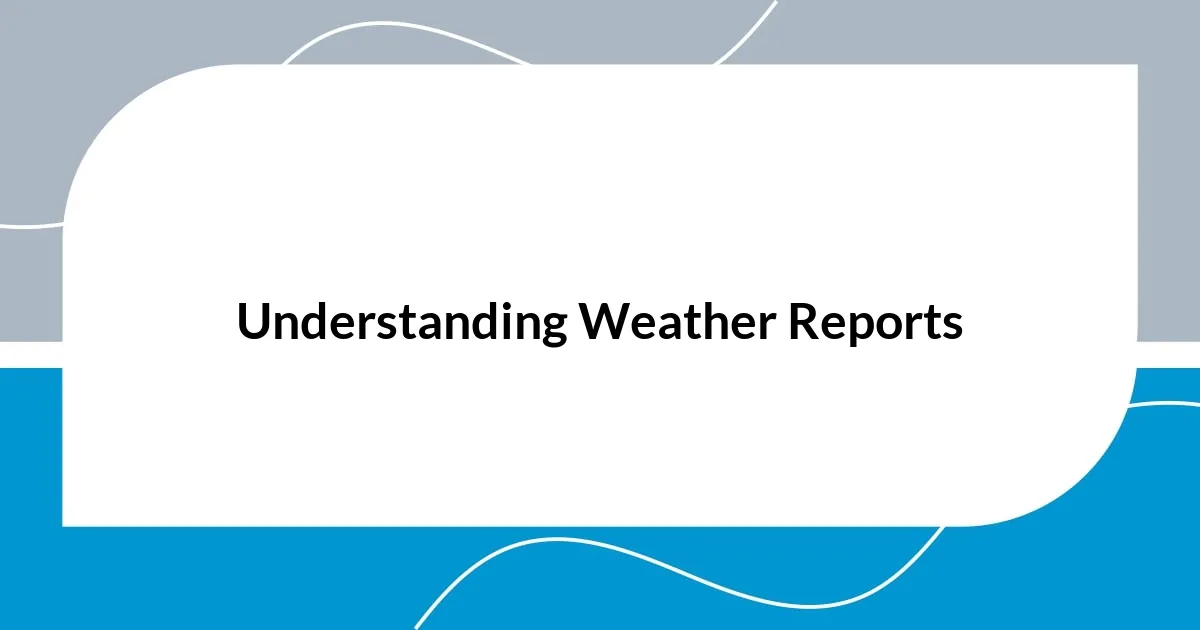
Understanding Weather Reports
Weather reports can sometimes feel overwhelming, with all those numbers and technical terms. I remember the first time I tried interpreting a forecast on my own—it felt like deciphering a secret code. But once I learned the basics, it became easier to understand the patterns and terminology, like why a “60% chance of rain” doesn’t always mean an umbrella is necessary.
One fascinating aspect of weather reports is how they delve into different factors, such as humidity and wind speed. These elements can dramatically alter the day ahead. For example, last summer, I looked at a report predicting a sunny day, but when I checked the humidity levels, I realized we’d be in for a sticky afternoon. Have you ever been caught off guard by how the conditions actually felt compared to what you expected?
Another crucial part of reading weather reports is understanding the visual aids they use, such as radar maps and icons. Initially, I thought those maps were just pretty pictures, but they offer incredible insight into imminent weather changes. So next time you glance at that radar image, take a moment to analyze it. Are those dark clouds moving your way? When I started honing in on these details, I felt way more prepared for whatever Mother Nature had in store.
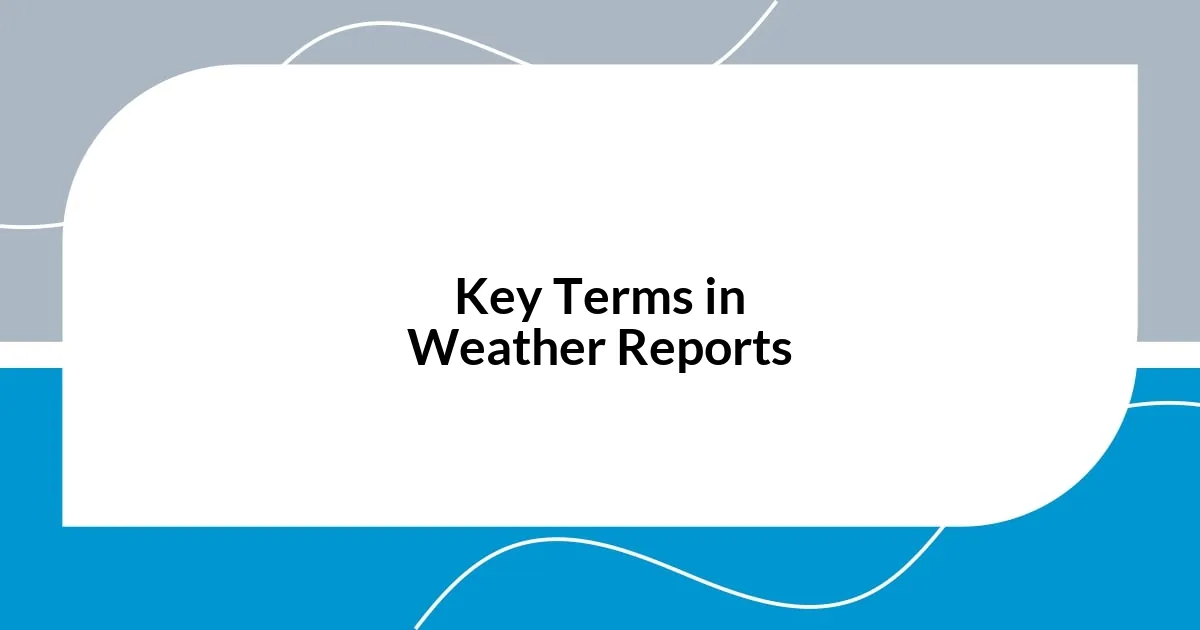
Key Terms in Weather Reports
Understanding key terms in weather reports can significantly enhance your ability to interpret forecasts accurately. I still vividly recall my confusion over terms like “barometric pressure” when I first dove into meteorology. It turns out that barometric pressure is simply the weight of the air above us, and it can give vital hints about upcoming weather patterns. A drop in pressure usually signals stormy weather, while a rise often means clearer skies.
Here are some essential terms to familiarize yourself with:
- Humidity: The amount of moisture in the air, affecting how we feel temperature-wise.
- Dew Point: The temperature at which air becomes saturated with moisture; a lower dew point generally means more comfortable conditions.
- Front: A boundary between two different air masses, which can lead to various weather changes.
- Severe Weather Alerts: Notifications that warn about potential hazards like storms or tornadoes, crucial for safety.
- Wind Chill: The perceived decrease in temperature felt due to wind; this can sometimes feel much colder than the actual temperature.
These terms might seem overwhelming at first, but as I learned each one, I felt more equipped to handle whatever weather surprises came my way. Each weather forecast started feeling like a puzzle that I could solve, enriching my understanding of nature’s whims.

How to Analyze Weather Data
I believe analyzing weather data is all about looking beyond the numbers. When I first started studying forecasts, I would simply glance at the high and low temperatures. However, I quickly noticed how crucial it was to pay attention to trends in the data. For instance, if a week shows consistent drops in temperature, you might want to prepare for a cold front. It was eye-opening to realize that data doesn’t just tell you what to expect; it also reveals patterns that can inform your future decisions.
Interpreting forecasts also means considering the source of the data. I remember my initial excitement when I discovered various weather apps and websites, but not all data is created equal. Some sources might exaggerate conditions or lack local context. I gradually learned that local meteorologists often provide forecasts with a better understanding of regional trends. The local flavor adds a level of nuance that national apps sometimes miss, making it key to verify with trusted local sources.
Lastly, I find that using a comparison table can help make sense of weather data visually. It organizes information clearly and emphasizes significant changes at a glance. Reflecting on my early days of analyzing weather reports, I remember creating such tables to chart temperatures over time, which turned the data into a tangible story. Not only does a table clarify the extremes, but it also marks potential shifts that might impact my plans or activities.
| Element | Importance |
|---|---|
| Temperature Trends | Indicates long-term changes; helps in planning. |
| Source Credibility | Trusted local sources enhance accuracy and relevance. |
| Historical Data | Provides context for current conditions; highlights patterns. |
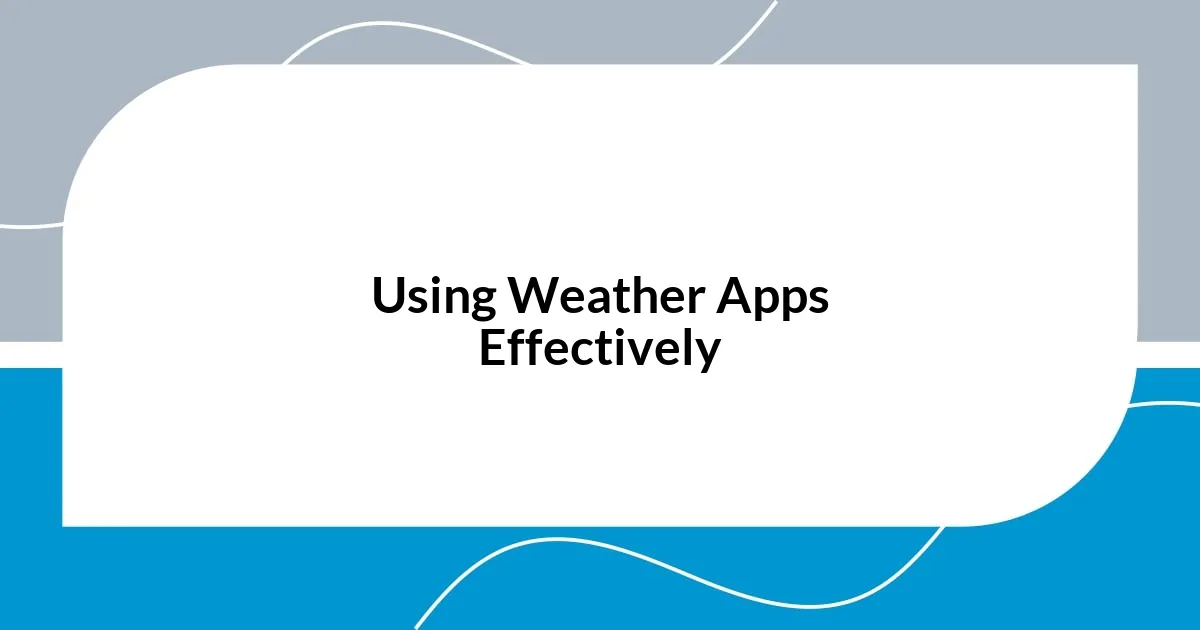
Using Weather Apps Effectively
When it comes to using weather apps effectively, I’ve found that personalizing the settings can make a significant difference. For example, I remember when I first downloaded a weather app—it felt overwhelming. But once I adjusted the location settings to track both my hometown and the places I frequently travel to, the information became much more relevant. Have you ever checked the weather for a vacation spot only to find it was completely off from what you were experiencing? I have, and it taught me the value of tailored alerts.
The layout of the app plays a crucial role, too. I once struggled with an app that buried crucial information under layers of graphics and animations. After switching to a more straightforward app that highlighted temperatures and precipitation right at the top, I felt like a weight had been lifted. It made planning my outings so much easier. What about you? Have you ever experienced the frustration of searching for key info on a cluttered screen? Simplicity helps me focus on what matters most.
I also appreciate the forecast details available, particularly the hourly predictions. One rainy Saturday, I found myself deep in plans with friends, and I quickly checked my app to see when the downpour was expected. By knowing that the rain would let up around 3 PM, I felt empowered to continue with our outdoor plans. Have you ever felt anxious about unexpected weather spoiling your fun? I certainly have, and it’s moments like that when timely, detailed information can be a game-changer.
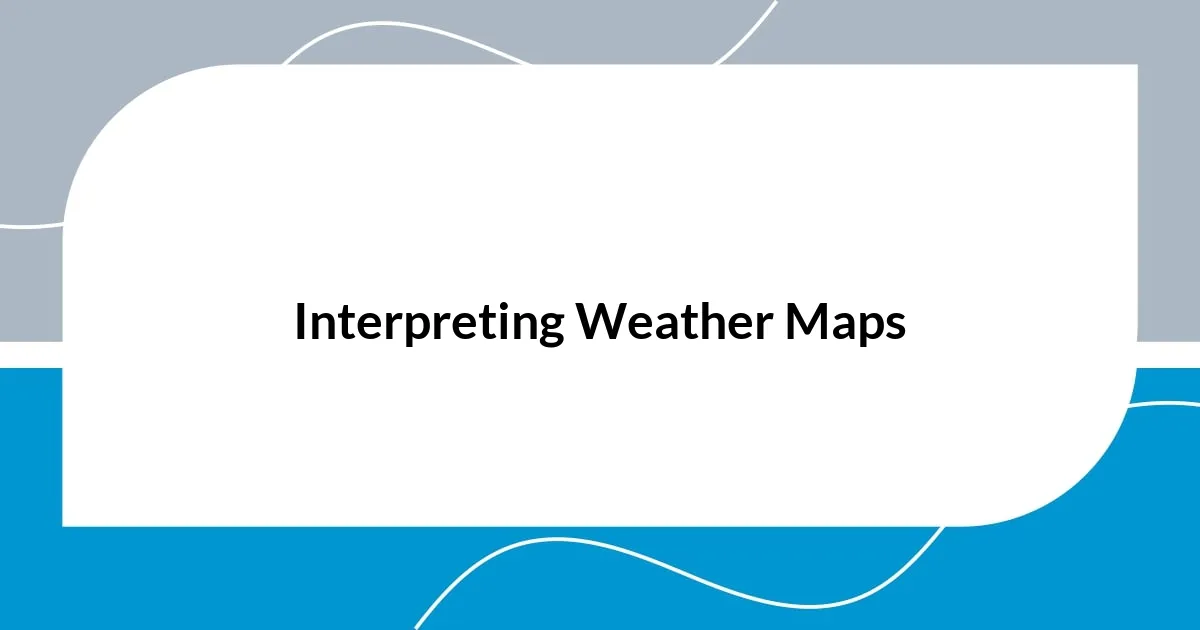
Interpreting Weather Maps
Interpreting weather maps can initially feel daunting, but I’ve found a few simple strategies that really help. One memorable morning, I was looking at a radar map showing a storm system approaching my area. By focusing on the color gradations—where darker shades indicated more intense precipitation—I was able to gauge how severe it might be. Have you ever unraveled a forecast by simply paying attention to these subtle cues? The colors on a weather map tell a story, and understanding that language can make a difference in how you prepare for the day.
I also learned to map out the isobars, those lines that connect points of equal pressure. The first time I noticed how closely packed they were, it hit me: strong winds were on the way. I remember making a plan for that afternoon, pushing our outdoor activities to the morning. It’s fascinating how a few lines can provide insight into upcoming weather phenomena. When you see isobars clustering together, ask yourself—what might that mean for my day ahead?
Lastly, I can’t stress enough the importance of understanding fronts on these maps. Each front indicates a shift in weather conditions, which can completely change your plans. Once, I was caught off guard by a cold front that swept through unexpectedly. Looking back, if I had recognized the symbol on the map, I could have bundled up before heading out. It’s a learning experience—each map I study teaches me something new. Are you ready to dive deeper into reading weather maps and see how they affect your life?
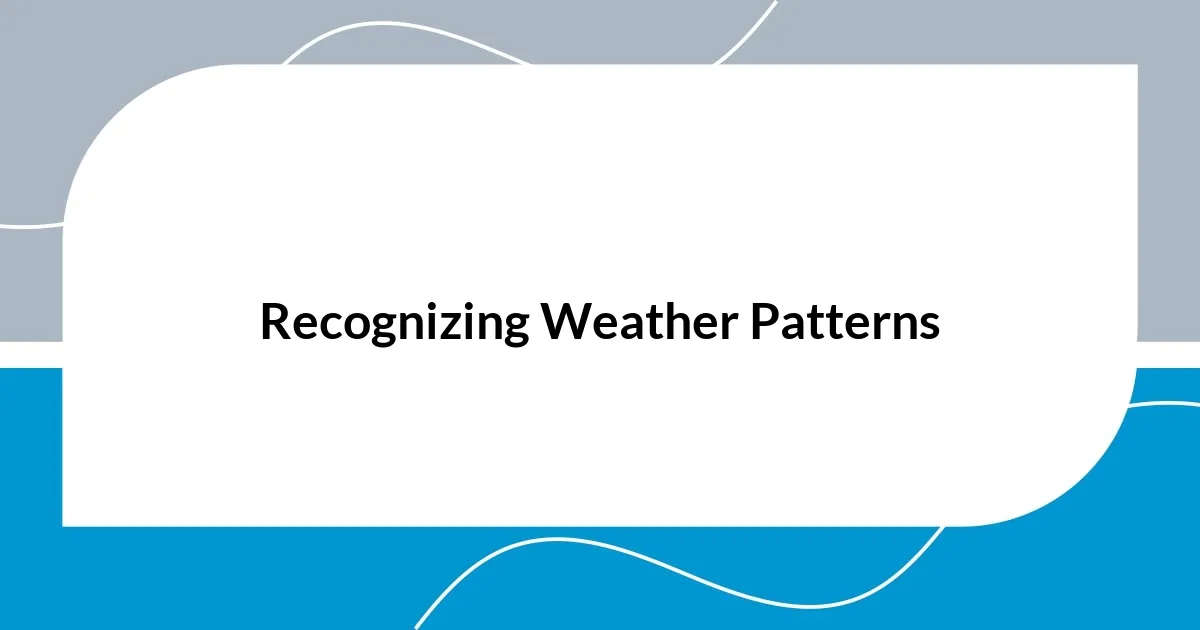
Recognizing Weather Patterns
Recognizing weather patterns is like tuning into nature’s own rhythm. For instance, I recall a summer when I noticed the frequent afternoon thunderstorms in my area. The days started out sunny, but clouds would build up around noon, leading to heavy rain by two. Have you ever sensed a pattern in your local weather like that? Picking up on these subtle cues can make planning your day much easier.
I’ve also found that changes in wind direction can signal shifts in weather. One windy day, I noticed how the breeze shifted from the west to the northeast. It struck me that a cold front was moving in, bringing possible rain later that evening. Have you ever had that feeling of anticipation as you watch the wind change? It’s a reminder that the elements are always in motion, and being aware of them makes me feel more connected to my environment.
Another aspect I pay attention to is the behavior of animals and plants. I remember being on a hike when I saw birds suddenly take flight and squirrels scurrying for cover. It was as if they knew something I didn’t. Shortly after, raindrops began to fall. Learning to recognize how nature reacts can be incredibly useful. Have you ever relied on such natural signs to predict the weather? Those moments deepen my appreciation for the world around us and the wisdom nature offers.

Planning According to Weather Forecasts
Planning according to weather forecasts can truly shape your day-to-day activities. I remember a camping trip I planned for the weekend, but the forecast warned of rain. Instead of risking a soggy experience, I shifted my plans to a more favorable day, and I’ll tell you—it made all the difference! Have you ever found that a simple glance at the forecast saved you from a potential disaster?
I’ve discovered that checking forecasts regularly can help me prepare better. Once, I overlooked a warning about high winds, thinking it wouldn’t affect my day. Later, while jogging, those winds made it tough to keep my balance, turning a pleasant run into a struggle. Learning to respect the forecast has become part of my routine. Isn’t it fascinating how a little preparation based on a weather report can enhance our experiences?
Moreover, weather forecasts aren’t just about what to wear. I’ve learned they can influence bigger decisions too. Take outdoor events, for instance—the time I organized a community picnic. Scanning the forecasts led me to reschedule it just one day ahead, preventing us from sitting in the rain and enjoying some lovely sunshine instead. How do you incorporate weather updates into your planning? Understanding their nuances can empower you to make choices that enhance both your safety and enjoyment.